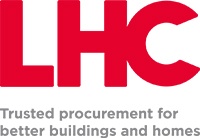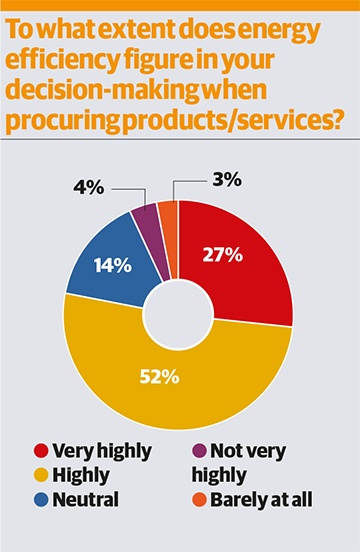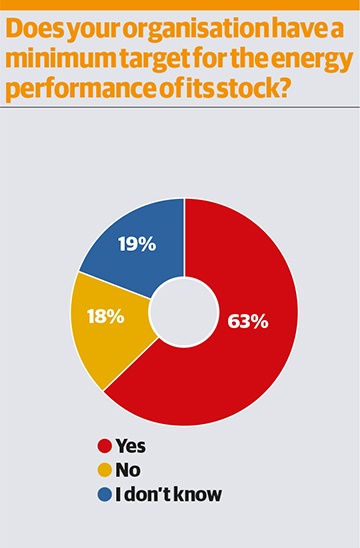Green gateway
Are social landlords taking energy efficiency seriously enough? Inside Housing and LHC carried out a survey to find out

Written in association with:

With ongoing benefit reforms putting pressure on tenants’ ability to pay rents, there is a clear incentive both morally and financially for social landlords to help them save money on their fuel bills. It is therefore important for housing providers to invest in energy efficient measures that will ensure their residents are living in warm, healthy homes.
Inside Housing and framework procurement specialist LHC sought to find out how seriously the sector takes energy efficiency. We launched a survey of housing professionals, asking a series of questions about the way their organisations procure energy efficient measures. A total of 196 respondents took part and the results tell an interesting story.
First, it is clear energy efficiency does figure highly in decision-making when procuring products and services. More than three-quarters of respondents rated the extent to which they consider energy efficiency ‘highly’ (52%) or ‘very highly’ (27%). Only 7% classified it figuring ‘not very highly’ or ‘barely at all’.
Simon Brown, director (asset management) at 11,000-home Liverpool Housing Trust, says that energy efficiency is high on the agenda for his organisation. However, it can be difficult to implement a significant change programme when minimal funding is available.
“There’s a difference between having something high on the agenda and putting £200m into it,” he says. “But there are simple things we can do that don’t need to cost the world, such as promoting fuel switching or undertaking basic energy measures - draught proofing etc.”
Respondents were asked what the major types of energy efficient or renewable measures their organisation typically specified were. The most popular responses were centred on improvements to the fabric of their stock. Almost three-quarters (74%) said their organisations usually specify cavity wall insulation, with 64% opting for external wall insulation. Photovoltaic systems also proved popular, with 47% saying they regularly procured the technology.
Procurement frameworks
Interestingly, there has been an unexpected growth in the number of people using procurement frameworks to specify many of these energy efficient measures. Over three-quarters of respondents (78%) have experience of using procurement frameworks, a massive rise from even five years ago, according to John Skivington, director at LHC.

“What I’d deduce from [the results] is that we do know that frameworks are used more for specialist, more complicated items where there’s a lot of choice and little knowledge or expertise in the market,” he says. “It makes sense: the more risk there is in procuring, the more likely that clients would find a framework provider with expertise in that area.”
To find out how much of a concern the energy efficiency of their stock was, the survey asked participants whether their organisation had a minimum target for energy performance. The majority of housing providers (63%) said that their organisation did have a minimum target, but 18% said they didn’t and a further 19% didn’t know.
Those that did have a target were also asked whether there was also a minimum Energy Performance Certificate (EPC) rating which their organisation aimed for. Ratings are split up in bands ranging from A (most efficient) to G (least efficient). The most popular EPC bands as a minimum ended up being Band D (25%) and Band C (20%), suggesting that landlords were targeting average levels of energy efficiency on the whole.
Ben James, energy and sustainability co-ordinator at 20,000-home Moat, selected Band E as his organisation’s minimum EPC rating, but for a good reason. New minimum energy efficiency standards come into force in April 2018 which mean that social landlords have to ensure their stock meets Band E or higher as a minimum for new lets and renewals.
“Having looked at our stock, the average Standard Assessment Procedure (SAP) rating is approximately Band C/D, so it’s just to make sure we don’t have any F/G-rated properties,” he says.
These more muted targets could be attributed to that fact social landlords have been operating in a challenging environment over the last few years. In addition to rent cuts, government subsidy for energy efficient measures has reduced or disappeared altogether.

Nearly half (49%) of participants said that reduced government funding was the most significant barrier to the wider installation of energy efficient measures across the UK. Perhaps unsurprisingly, our respondents largely agreed with the statement that government policy is not supportive to the wider adoption of energy efficient measures (52%).
Funding issues
Additionally, they felt economic uncertainty had made it more challenging to invest in energy efficiency, a statement which 62% of respondents agreed with.
Mr Skivington says that social landlords haven’t been helped by an erratic approach to funding for energy efficient measures since the turn of the decade. A number of schemes, such as the Green Deal, Feed-In Tariffs and ECO, have come and gone in quick succession.
“Providers were considering developing their renewable plans, looking at how best to maximise that funding,” he says. “Some associations thought they would use their own money instead of waiting for the government, then the rent cap and everything else affected that, so there’s been a double-whammy.”
However, despite these challenges, interestingly a large proportion of landlords still expect their organisation’s spend on energy efficiency measures to increase next year. Forty per cent said that their spend would rise, whereas just 25% said that it would decrease.
Karen Hilton, energy advisor at 1,600-home Fyne Homes, says that energy efficiency spend is set to rise at her association because of the need to comply with the Scottish Government’s Energy Efficiency Standard for Social Housing (EESSH). Under EESSH, all social properties will have to meet ‘C’ or ‘D’ energy efficiency rating as a minimum by 31 December 2020.
“The majority of [our properties] do pass; we do have problematic ones dotted around and that’s probably what we’ll need to concentrate on,” she says.
The principal area in which social landlords were most in agreement, however, was on the main reasons why they invest in energy efficiency. The common theme which kept being repeated again and again in their responses was that they want to reduce customers’ energy bills and address fuel poverty.
“It’s been reported that there has been a shift away from community as the economic pressures have been driven into social landlords, so it’s good to see it coming out here as the key driver,” concludes Mr Skivington.






